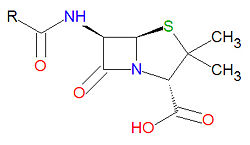Penicillin: Difference between revisions
imported>Howard C. Berkowitz No edit summary |
imported>Howard C. Berkowitz No edit summary |
||
| Line 4: | Line 4: | ||
'''Penicillin''' refers to a class of [[antibiotic]] drugs that have a common [[beta-lactam|<math>\beta</math>-lactam]] core structure. Characteristics of penicillins, especially bioavailability, can vary substantially depending upon the R- group appended onto the core structure. Some penicillin drugs are actually prodrugs that only become active after some metabolitic transformation within a patient. Penicillin drug may cause severe, even fatal, allergic responses in some patients. Some bacteria have developed resistance to penicillin through the acquisition of [[beta-lactamase|<math>\beta</math>-lactamases]], enzymes which degrade the <math>\beta</math>-lactam structures of the penicillin drugs. | '''Penicillin''' refers to a class of [[antibiotic]] drugs that have a common [[beta-lactam|<math>\beta</math>-lactam]] core structure. Characteristics of penicillins, especially bioavailability, can vary substantially depending upon the R- group appended onto the core structure. Some penicillin drugs are actually prodrugs that only become active after some metabolitic transformation within a patient. Penicillin drug may cause severe, even fatal, allergic responses in some patients. Some bacteria have developed resistance to penicillin through the acquisition of [[beta-lactamase|<math>\beta</math>-lactamases]], enzymes which degrade the <math>\beta</math>-lactam structures of the penicillin drugs. | ||
Although the [[discovery of penicillin]] is often attributed to Flemming, organisms which produce them have been used since ancient times to treat infections. | Although the [[discovery of penicillin]] is often attributed to Flemming, organisms which produce them have been used since ancient times to treat infections. Natural and semisythetic penicillins are produced by fungi: the original strain producing penicillin G (benzylpenicillin) was ''Penicillium notatum'', although the industry changed to a higher-yielding ''P. chrysogenum''. Semisynthetic penicillins have precursor chemicals added to the culture media, which are incorporated into the antibiotic molecule. | ||
For more information about specific penicillin drugs, see these pages: | For more information about specific penicillin drugs, see these pages: | ||
Revision as of 22:07, 9 August 2010
Penicillin refers to a class of antibiotic drugs that have a common -lactam core structure. Characteristics of penicillins, especially bioavailability, can vary substantially depending upon the R- group appended onto the core structure. Some penicillin drugs are actually prodrugs that only become active after some metabolitic transformation within a patient. Penicillin drug may cause severe, even fatal, allergic responses in some patients. Some bacteria have developed resistance to penicillin through the acquisition of -lactamases, enzymes which degrade the -lactam structures of the penicillin drugs.
Although the discovery of penicillin is often attributed to Flemming, organisms which produce them have been used since ancient times to treat infections. Natural and semisythetic penicillins are produced by fungi: the original strain producing penicillin G (benzylpenicillin) was Penicillium notatum, although the industry changed to a higher-yielding P. chrysogenum. Semisynthetic penicillins have precursor chemicals added to the culture media, which are incorporated into the antibiotic molecule.
For more information about specific penicillin drugs, see these pages:

